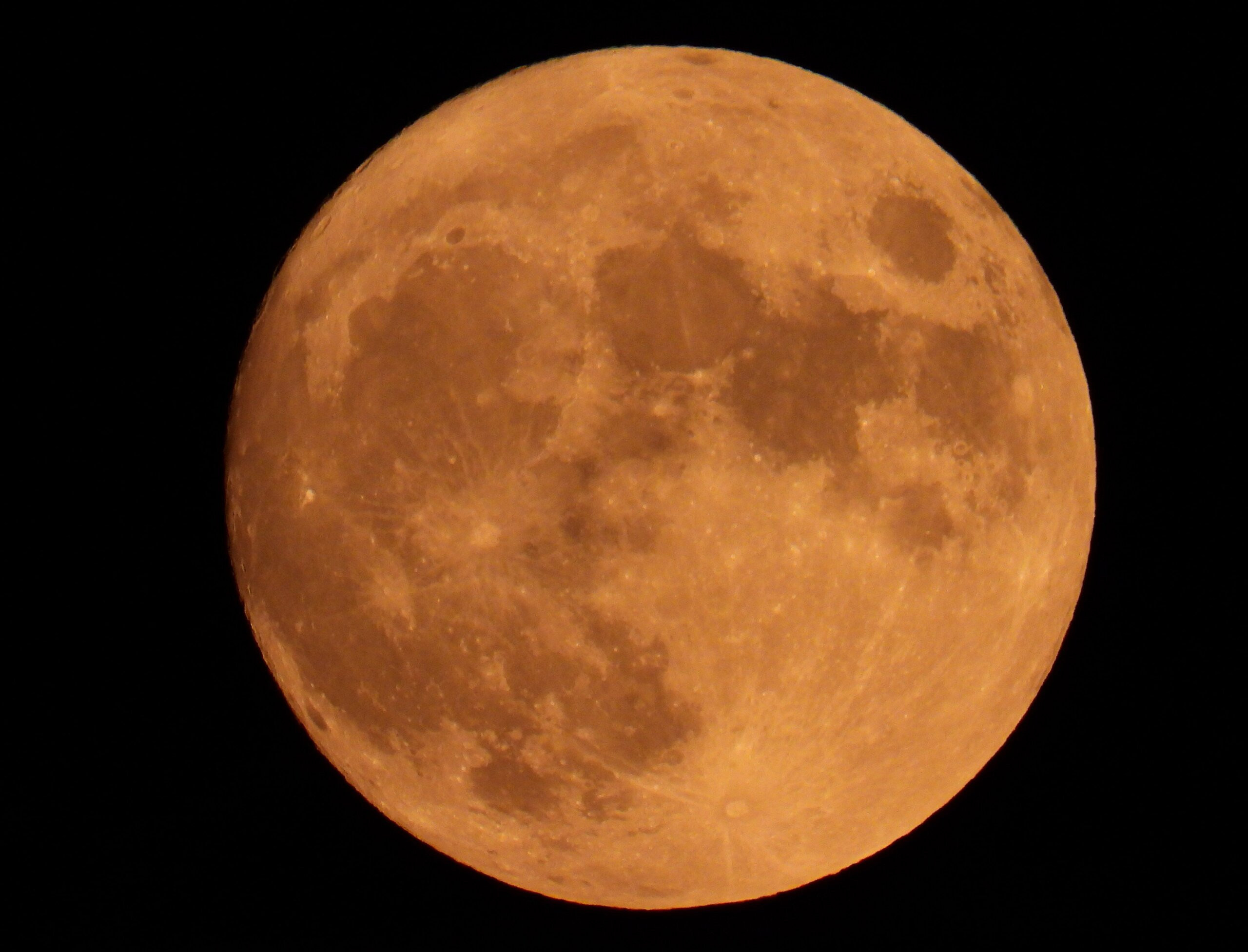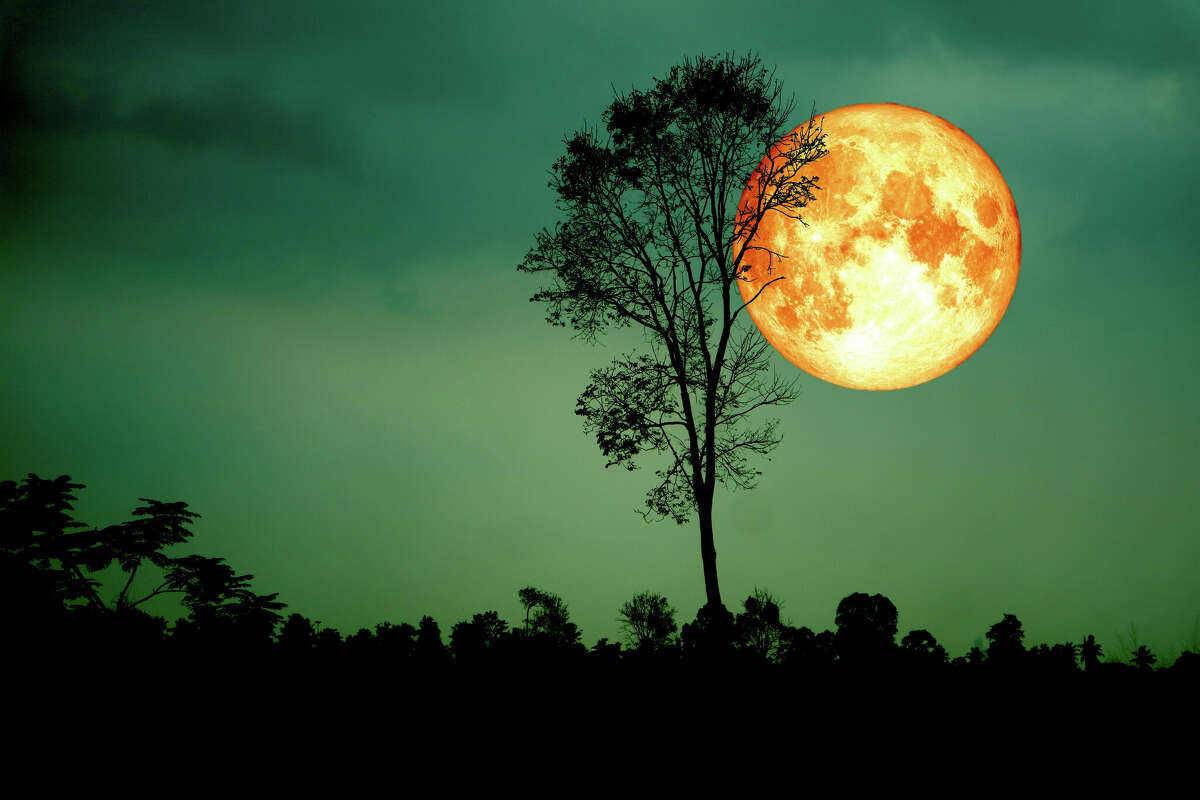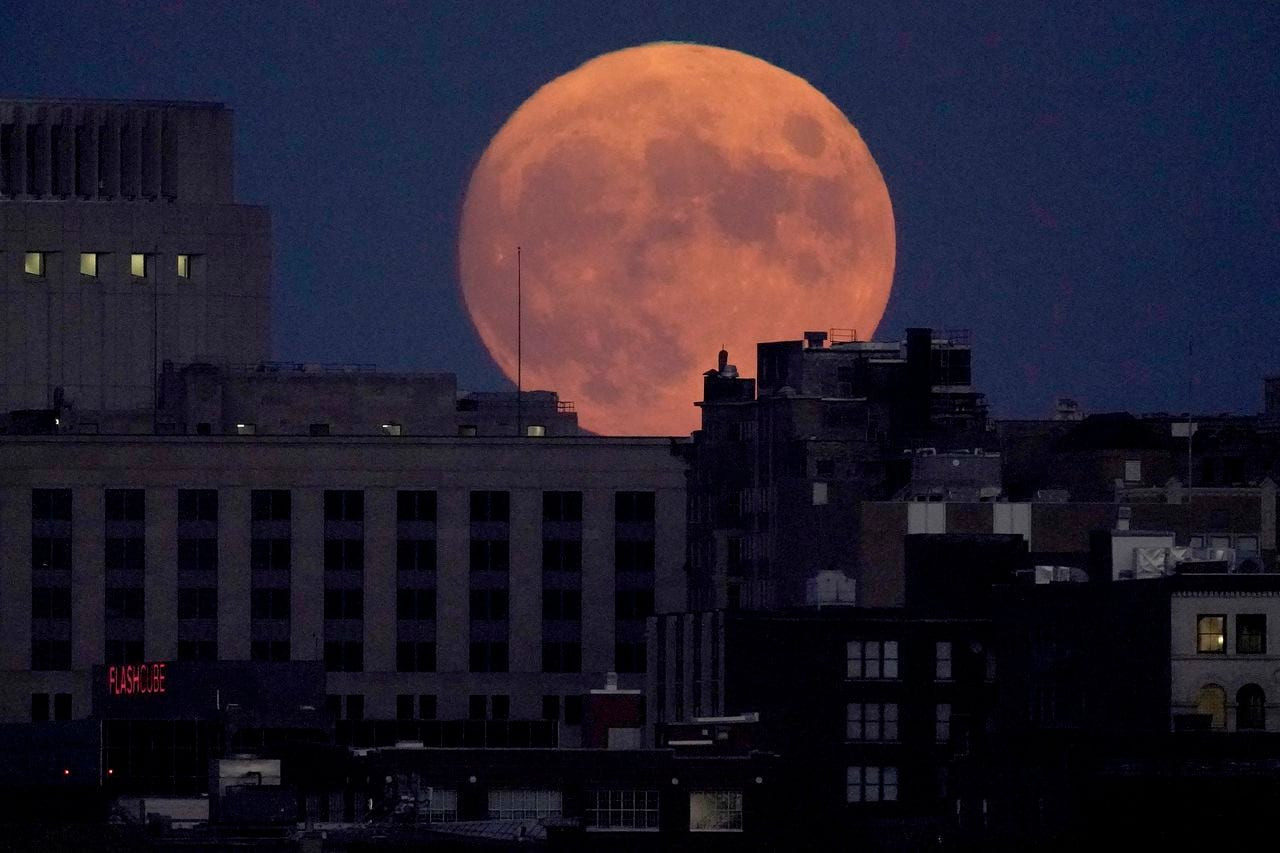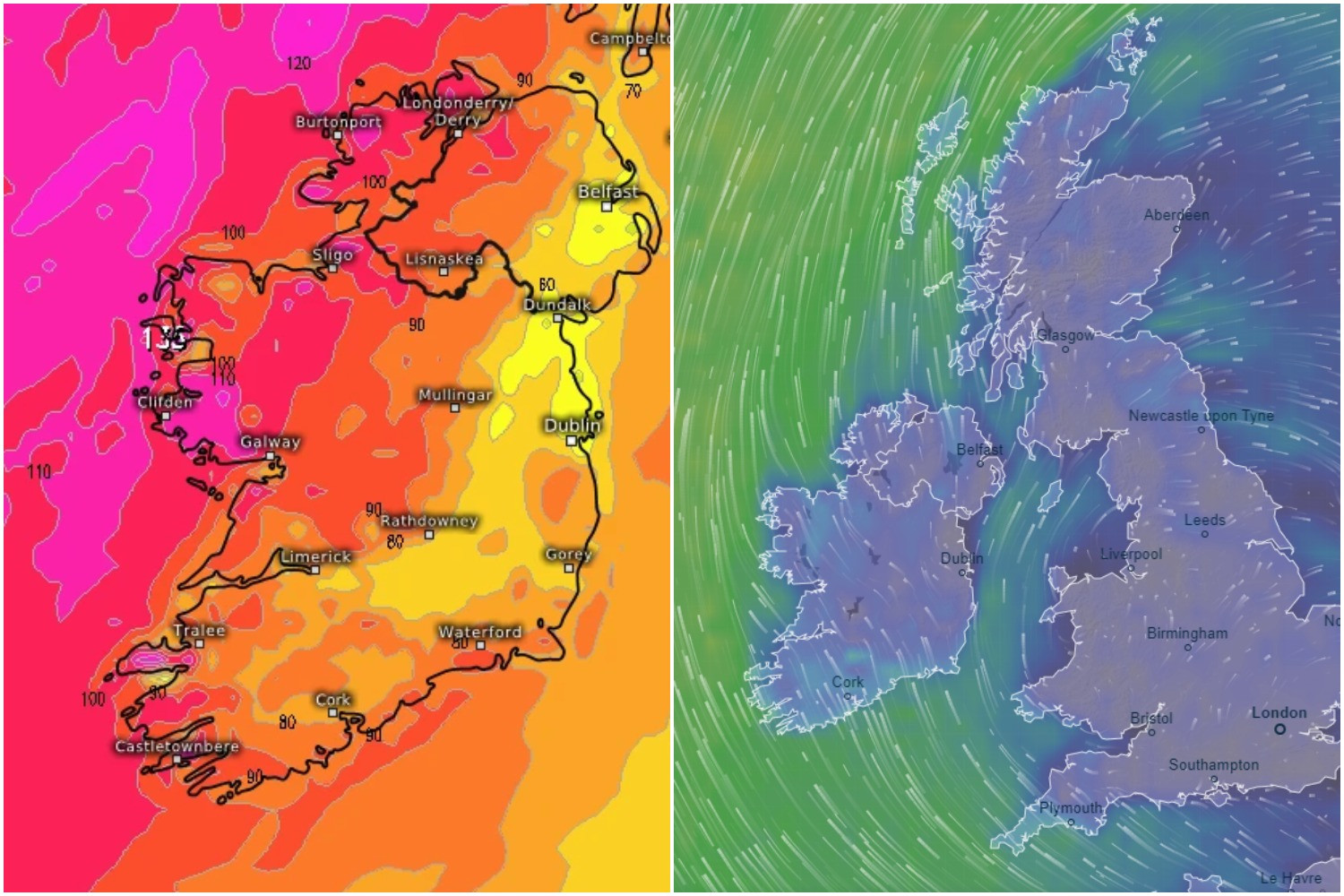Moongazers are getting a treat tonight, as this year's harvest moon coincides with two other lunar events - but what do their names actually mean?
Tonight's full moon is a harvest moon, supermoon and lunar eclipse all rolled into one. The spectacle should be visible across the UK, if skies stay clear.
Lunar Eclipse
A partial lunar eclipse happens when the Earth passes between the sun and moon and casts a shadow. Tonight, it'll be visible in the top right corner of the moon - you'll see a sliver of the moon has disappeared; that's Earth's shadow. To spot the moon's subtle shrinkage over time, spend a few hours outside or take multiple peeks over the course of the evening, KaChun Yu, curator at the Denver Museum of Nature and Science, advises.
Supermoon
The partial lunar eclipse is coinciding with the second of four supermoons in as many months. A supermoon occurs when a full moon is at its closest point to Earth during its orbit, making the moon look bigger than usual. The best time to spot a supermoon is in the early evening, when it is on the horizon. That's when it'll appear at its largest and may be slightly orange because of the effect of moonlight shining through Earth's atmosphere. The lunar eclipse will happen in the early hours of Wednesday morning though, so don't forget to look again later on. After this, the next supermoon will be on 17 October and the final one on 15 November.
Harvest Moon
Unlike the supermoon and eclipse, the harvest moon isn't to do with what it will look like but the time of the year. Throughout the year, there are various mystically named moons, like January's wolf moon or July's buck moon, and their names are all to do with what is going on in the natural world at that point. The harvest moon is usually in September and is the full moon which occurs closest to the autumn equinox. The moon at this time of year tends to be bright and rises soon after sunset, so it offers farmers gathering their harvests more light to work into the night; hence the name "harvest moon".
Temperatures are cooling...slightly, and fall is on its way. To usher in the start of the harvest season is another supermoon. September's full moon, known as the "harvest moon," will be a sight to behold because it is also a supermoon that will appear bigger but it will also be around for a bit. According to NASA, the moon will appear full for about three days, from Monday evening through Thursday morning. People will also get to see a partial lunar eclipse along with the full moon.
Here's when you can see the full moon, why it is known as the harvest moon and when the partial lunar eclipse will happen.
The September full moon is known as the harvest full moon because it is usually the moon that occurs closest to the autumnal equinox, which is Sept. 22 this year. This time of year is also when the season comes to an end for summer crops and when the last of them need to be harvested.
The moon is going to look pretty big this month because it is also a supermoon.
A supermoon occurs when the moon is at its closest approach, or perigee, to the Earth in its 27-day orbit. The moon also needs to be at the full phase, which happens every 29.5 days, according to Space.com. Usually, supermoons only occur a few times a year at the most, which is due to changes in the moon's orbital orientation while the Earth orbits the sun.
Even though supermoons might only happen a couple of times a year, we get to see four in a row in 2024. August was the first in the series of four supermoons, with the closest supermoon to the Earth happening on Oct. 17, at 6:26 CT/7:26 a.m. ET.
People will have the best view of the partial lunar eclipse on Tuesday just after the peak of the full moon around 10:44 p.m. ET. The top eight percent of the moon will be in full shadow at that moment.
The next total lunar eclipse visible from the Americas will be March 14, 2025.
Each full moon has its own name. Here in North America, we take the names for the full moons from Indigenous peoples usually from different areas of North America.
In the 1930s the Maine Farmers' Almanac began publishing names used among the Algonquin tribes from New England on west to Lake Superior. Here's a look at when other full moons are expected to happen in 2024, according to NASA:
Moon lovers have a reason to celebrate this week.
A full moon on Tuesday will coincide with a partial lunar eclipse, giving people in North America, South America, Africa and Europe a chance to see part of the moon’s surface obscured by Earth’s shadow.
A partial lunar eclipse occurs as Earth passes between the moon and the sun, creating a celestial alignment that blocks sunlight from hitting the lunar surface.
Tuesday’s event will feature September’s full moon, which is known as the harvest moon because it is often associated with harvest time in the Northern Hemisphere, according to NASA.
It will also be a supermoon, because the moon will be at its closest point to Earth in its elliptical, 27-day orbit. When a full moon happens to occur at the same time as its closest approach to Earth, it appears slightly bigger and brighter than the average full moon, which is why it is known as a “supermoon.”
The partial lunar eclipse will begin Tuesday evening at 8:41 p.m. ET, when the moon starts entering part of Earth’s shadow. Even with good weather and clear conditions, the dimming effect will likely be tricky to see until the top edge of the moon becomes obscured at around 10:13 p.m. ET, according to NASA.
The eclipse will peak at 10:44 p.m. ET, when roughly 8% of the moon’s surface will be in full shadow. This will come about 10 minutes after the moon becomes full at 10:35 p.m. ET.
After the peak of the eclipse, the moon will begin exiting Earth’s shadow, ending early Wednesday at around 12:47 a.m. ET.
Unlike with solar eclipses, there’s no need to wear protective eyewear when watching a lunar eclipse and it can be viewed safely with the naked eye.
Denise Chow is a science and space reporter for NBC News.
Stargazers will be in for another celestial treat Tuesday night as three cosmic events will occur at the same time during the full moon.
After last month brought space enthusiasts a blue supermoon, September’s harvest moon will not only coincide with a supermoon, but also with a blood moon and partial lunar eclipse.
While harvest moons happen each year close to the start of fall and supermoons three to four times a year, all three events taking place at the same time are “quite rare,” astrophysicist Teresa Monsue of NASA's Goddard Space Flight Center told NPR.
The moon is considered “super” when it is full and its orbit is at the closest point to Earth, according to NASA. When the Earth is positioned between a full moon and the sun, and the moon passes through Earth’s shadow, a lunar eclipse takes place.
The best times to view the event will depend on your location, but the lunar eclipse will peak at 10:44 p.m. ET, according to NASA. All of North and South America will have a chance to see the partial lunar eclipse and harvest supermoon depending on the weather. Europe and Africa will also have an opportunity to see the eclipse.
This lunar eclipse will be a partial one, with only the upper portion of the moon being plunged into the darkest part of the Earth's shadow known as the umbra, Monsue said.
“Aside from the small darkened portion at the top of the moon's disk, most of the visible lunar disk will be in Earth's penumbra, the lighter portion of the planet's shadow that does not entirely block the sun's light,” she also said, adding that this will give most of the moon a reddish-brown appearance that we call a “blood moon.”
And unlike a solar eclipse, where you must wear special glasses to protect your eyesight when looking at it, skygazers can see Tuesday’s lunar eclipse with ease and without eye protection.
“It is safe to look directly at the moon during a lunar eclipse, because it is reflected light that is no brighter than moonlight,” Monsue said.
The eclipse should also be a good chance for views of contrast on craters and other features on the lunar surface if you use a telescope or binoculars, she said.
If you miss Tuesday night’s eclipse and supermoon, unfortunately the next one will not happen until Oct. 8, 2033, according to Monsue.
But you will be able to see another full supermoon on Oct. 17 and a total lunar eclipse on March 14, 2025.
There will also be an annular solar eclipse, or “ring of fire” eclipse, when the moon passes between the Earth and sun, but is at or near its farthest point from our planet, on Oct. 2. But the only potential viewers within the U.S. that will have a chance to see it will be in Hawaii.
September's full moon will put on quite the show on the evening of Sept. 17. Not only are we treated to a slightly larger-than-average "supermoon" but also a partial lunar eclipse.
On the evening of Sept. 17, a partial lunar eclipse will turn the moon a murky red-brown color when Earth's shadow descends upon the lunar surface.
The partial lunar eclipse will be visible from most of North America, all of South America, Europe, all but the easternmost parts of Africa, western portions of Asia and Russia, and parts of Antarctica.
The exact timing of the partial lunar eclipse depends on your location and you can use websites like Timeanddate.com to find specific timings based on your location. For those in the U.S. Eastern Time Zone, the eclipse will reach its darkest phase, with the moon most obscured by Earth's umbra, at approximately 10:44 p.m. EDT on Sept. 17. In Europe and Africa, the eclipse will occur during the early morning hours of Sept. 18. In London, the peak of the eclipse will be visible around 3:45 a.m. BST on September 18.
If you are unable to watch the lunar eclipse in person you can watch all the action unfold online here on Space.com. We have rounded up several lunar eclipse livestreams that are showing the Super Harvest Moon on Sept. 17.
Looking for a telescope for the moon? We recommend the Celestron StarSense Explorer DX 130AZ as the best for basic astrophotography in our best beginner's telescope guide.
In a partial lunar eclipse, only a portion of the moon passes into Earth's shadow, creating the appearance of a hazy "bite" taken out of the lunar surface. The shadow will darken the side of the moon facing Earth. The size of this "bite" is determined by the alignment of the sun, Earth, and moon.
About 3.5% of the moon's visible surface will be covered by the darkest part of Earth's shadow, the umbra. The rest of the Full Moon will take on a slightly reddish-brown appearance as the lighter portion of Earth's shadow which doesn't entirely block the sun's light will descend upon a majority of the lunar surface.
The partial lunar eclipse is extra special as it also falls during a "supermoon", the second of four supermoons in a row for 2024.
A supermoon happens when a full moon coincides with the moon's closest point to Earth in its orbit (which is elliptical-shaped). As a result, the moon appears slightly brighter and larger than usual, although the difference is subtle and hard to detect with the naked eye.
The term supermoon generally refers to a full moon within 90% of its closest approach to Earth. According to Fred Espanak, eclipse expert and retired NASA astrophysicist, there will be four supermoons in 2024, in August, September, October and November.
Approximately two weeks after the lunar eclipse Earth will experience an annular solar eclipse on Oct. 2. The dazzling "ring of fire" solar eclipse will be visible over parts of the Pacific Ocean, southern Chile and southern Argentina.
You can keep up with all the solar eclipse action with our solar eclipse live blog. We will also be streaming the eclipse live on Space.com, more details on how to watch online will be released closer to the time.
Editor's note: If you snap a great picture of the moon during September's partial lunar eclipse, and would like to share it with Space.com's readers, send your photo(s), comments, and your name and location to [email protected].
Join our Space Forums to keep talking space on the latest missions, night sky and more! And if you have a news tip, correction or comment, let us know at: [email protected].
Daisy Dobrijevic joined Space.com in February 2022 having previously worked for our sister publication All About Space magazine as a staff writer. Before joining us, Daisy completed an editorial internship with the BBC Sky at Night Magazine and worked at the National Space Centre in Leicester, U.K., where she enjoyed communicating space science to the public. In 2021, Daisy completed a PhD in plant physiology and also holds a Master's in Environmental Science, she is currently based in Nottingham, U.K. Daisy is passionate about all things space, with a penchant for solar activity and space weather. She has a strong interest in astrotourism and loves nothing more than a good northern lights chase!
A Super Harvest Moon Lunar Eclipse Will Light Up The Night Sky On Sept. 17.
The full moon, also known as Harvest Moon, will arrive on Sept. 17.
A new full moon is arriving in September, also known as "harvest moon" as summer comes to a close and fall is making its entrance.
Celebrity astrologer Kyle Thomas, who is known for his cosmic guidance among celebrities, businesses and online influencers, spoke to "Good Morning America" about the best ways to take advantage of this powerful and emotional lunar event.
In collaboration with J. Paul Getty Museum, Thomas will be participating in Getty's "Rising Signs: The Medieval Science of Astrology" exhibition during which he will be part of a panel in an online conversation on Oct. 3 to discuss the connection between medieval astrology and popular contemporary practice. Learn more about the event here.
But first, let's break down the meaning of the harvest moon.
The full moon will reach peak illumination in the United States on Tuesday, Sept. 17, at 10:35 PM E.T., according to NASA.
The moon will appear full for about three days, from Monday evening through Thursday morning, the agency said, adding that this full moon will also feature a partial lunar eclipse.
Lunar eclipse is a natural phenomenon that occurs when the Earth passes between the sun and the moon. This causes the Earth's shadow to fall on the moon, making it appear darkened and reddish.
For this particular event that takes place during the harvest moon, the moon will start entering the Earth's partial shadow at 8:41 PM E.T., and the full shadow at 10:13 PM, according to NASA.
The moon will finish exiting the full shadow at 11:16 PM and the partial shadow on Wednesday morning at 12:47 AM.
This year's full moon in September is also referred to as a supermoon, which occurs when a moon is at or near the closest point in its orbit, causing the harvest moon to look dramatically more radiant and larger than usual.
The Old Farmer's Almanac, which first began publishing the names for the full moons in the 1930s, states the full moon was named the harvest moon because for several evenings, the moon rises shortly after sunset, resulting in an overflow of bright moonlight soon after dusk.
This period became a customary aid to farmers during crop gathering.
The harvest moon can take place in September or October depending on its proximity to the autumnal equinox.
Another full moon that could also occur in September is known as corn moon which represents the period for gathering main staple crops of corn, pumpkins, squash, beans, and wild rice, according to NASA.
The zodiac sign for each full moon is determined by where the moon is positioned in the night sky relative to the different astrological signs. Each year, the moon will shift, resulting in different characteristics surrounding the moon, according to Thomas.
This year, the harvest moon is a lunar eclipse in Pisces, a water sign and the 12th and last zodiac on the wheel. It's on the opposite Axis from the earth sign, Virgo.
"This means that both zodiac signs hold ties to our health — physical or mental — as well the physical or spiritual world," Thomas said. "This duality grounds us in the practical while also opening us up to the divine, as well."
Many ancient cultures and religions celebrate celestial cycles, including finding ways to honor and harness the power of the full moon.
To make the best use of this intense energy, many astrologers believe that a full moon is a great time to manifest your dreams.
Thomas said it is never encouraged to manifest during an eclipse moon due to the energy being "incredibly chaotic, intense and high-powered."
"Lunar eclipses are three times more powerful and emotional than full moons," he added.
Thomas recommended asking questions of yourself and the universe to be an even more effective way of engaging this energy.
Potential meditations, mantras or journal prompts:
Aries (March 21 - April 19)
Relax and recharge, Aries!
"This lunation could help you to truly tap into your innate psychic abilities and intuition," Thomas said. "Listen to what the universe is telling you."
Taurus (April 20 - May 20)
Get out and mingle, Taurus!
"You'll likely be surrounded by many friends, fans or followers!" according to Thomas who added, "this lunation spotlights your social network and connections, so you could be attending a milestone event or even meeting many new people."
Gemini (May 21 - June 20)
The sky's the limit, Gemini!
"Get ready to soar higher toward the stars!" Thomas explained. "This lunation spotlights your professional world and could bring a promotion, award, accolade or new job offer. Hustle hard at this time; you'll get very far now."
Cancer (June 21 - July 22)
Broaden your horizon, Cancer!
"As the lunation arrives, you could be propelled to swim into new territory," Thomas said. "This may energize you to book a flight and venture out or plan a fun vacation in the year to come."
Leo (July 23 - Aug. 22)
A lucrative opportunity could be just around the corner, Leo!
"A big payout, bonus, scholarship, inheritance or benefits package could be swimming your way," Thomas added. "This could also bring news around your assets or investments."
Virgo (Aug. 23 - Sept. 22)
Pay attention to your relationship, Virgo!
"A big turning point around a significant relationship could be at hand," Thomas said. "You may move in, make a long-term promise, commit, get engaged or even be wed."
Libra (Sept. 23 - Oct. 22)
Get busy and productive, Libra!
"The lunar eclipse is cranking your productivity up to hyper speed!" Thomas explained. "You may be polishing off a big project for your employer, taking on more responsibilities or even leaving one job to begin another."
Scorpio (Oct. 23 - Nov. 21)
Dive into the magic, Scorpio.
According to Thomas, "the lunar eclipse will sing like angels from above. Romance, passion, pleasure, art, beauty and fertility all shine at this time."
Sagittarius (Nov. 22 - Dec. 21)
A change is on the horizon, Sagittarius!
"The lunar eclipse could cause a shift around your home, real estate, family or parents," Thomas said. "For instance, you may choose to move, redecorate or have a renovation."
Capricorn (Dec. 22 - Jan. 19)
Embrace the win, Capricorn!
"With this lunation energizing your mind, you could be debuting or working on a major intellectual, writing, speaking, advertising, branding or communications-related project," Thomas said.
Aquarius (Jan. 20 - Feb. 18)
A financial transition is underway, Aquarius!
"This lunar eclipse will likely not only bring money in — but also cause you to invest it in the right places, too," Thomas explained. "A raise, new client, new job offer or side hustle may appear near this time."
Pisces (Feb. 19 - March 20)
Own the spotlight, Pisces!
"A very important personal goal or dream may now be in reach — as well as a shift around a significant relationship," Thomas added. "Now is the moment to step into your power, assert yourself and show everyone why you're so beautiful, magical and unique."
24/7 coverage of breaking news and live events



















